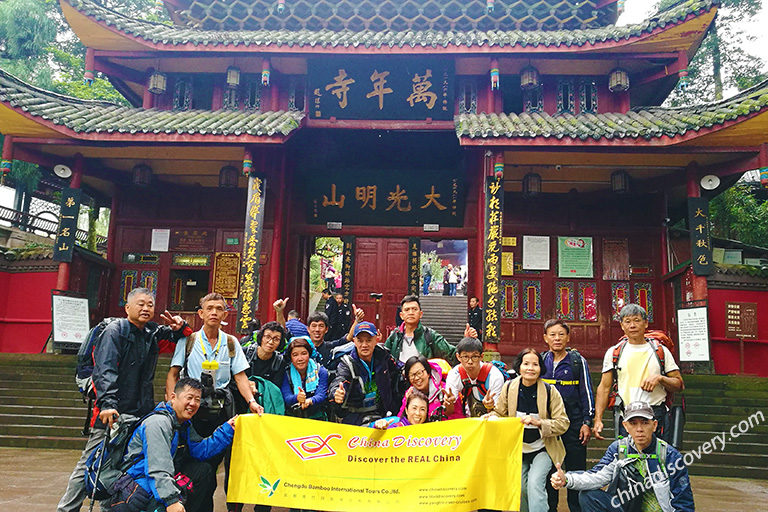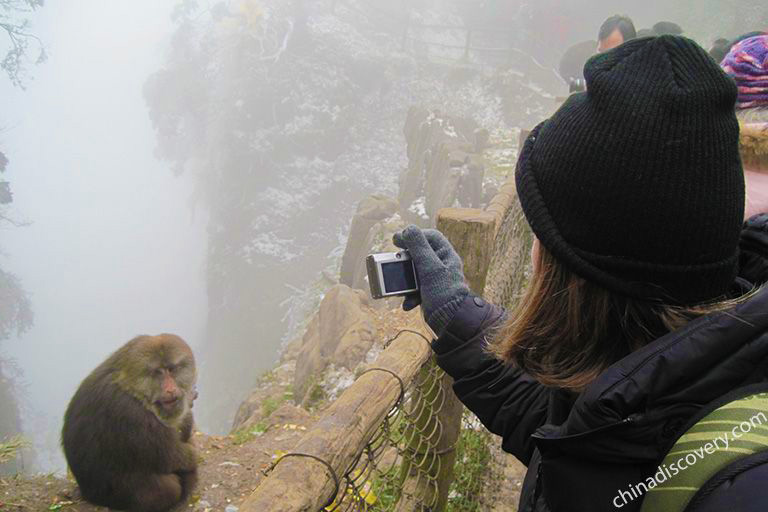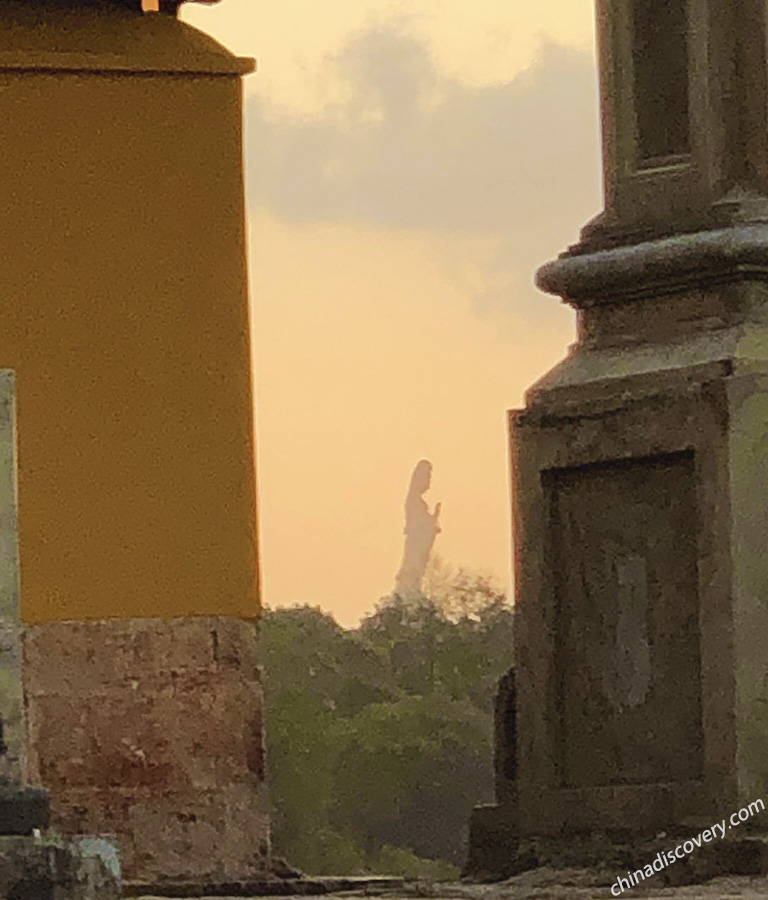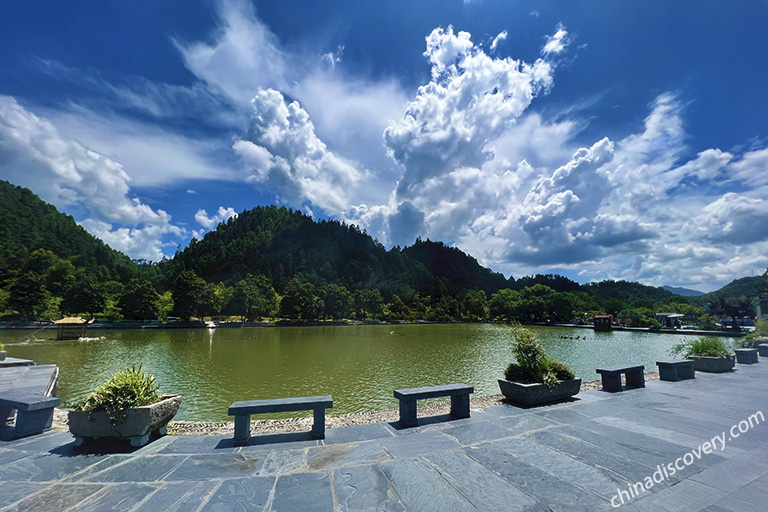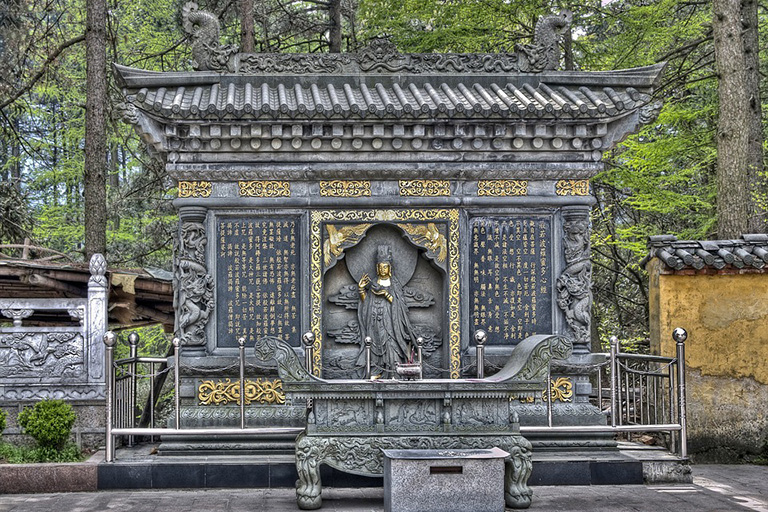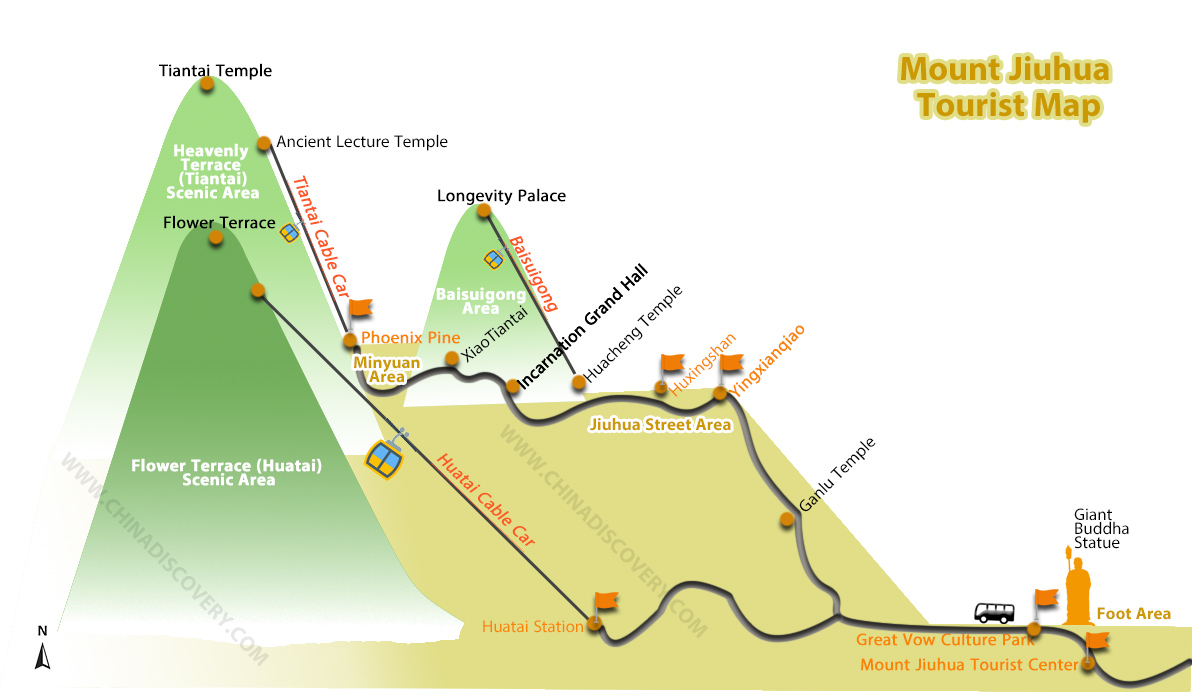Ranking the Four Sacred Buddhist Mountains in China
As the introduction of Buddhism from India in Han Dynasty, China initiated temple construction and sites of enlightenment and continues today. The Buddhist culture in China went through long history of growth and prosperity, and ultimately turns into historical appeal and cultural charm together with the attractive natural scenery where they pullulated, achieved fame throughout the world. Among the numerous famous Buddha Mountains in China, the most sacred four are known as Gold Wutai, Silver Putuo, Copper Emei and Iron Jiuhua respectively for they believed to be the holy seats Manjusri Buddisattva, Avalokitesvara, Samantabhadra Bodhisattva and Ksitigarbha Buddhisattva reincarnated to tame certain beings. Check the full list to know more about Buddhist culture in China now.
Quick Jump to:
1. Mount Emei in Sichuan - World Cultural & Natural Heritage
Recommended Rating: 
TripAdvisor Impression: Life Experience, Breathtaking View, Amazing Place, Beautiful Mountain Top
Type: Religious & Historical Site, Nature & Parks, Sights & Landmarks with Monkey
Elevation: 3099m (10167ft)
Best Travel Time: March to December. Spring (March to April) and Autumn (September to October) are the best seasons of Mount Emei when the weather is pleasantly mild, beautiful azaleas bloom over the mountains and Buddhist Temple Worship held in Spring, dazzling red leaves making up picturesque views in Fall. Generally tourists can visit Mount Emei full year for it has distinctive characters in each season.
Recommended Visiting: one ~ three days
Ticket: CNY160 in Peak Season (January 16 - December 14) and CNY110 in Off Season (December 15 - January 15); Wannian Temple: CNY10; Baoguo Temple: CNY8, Fuhu Temple: CNY6; extra costs for cableways and tour bus are excluded.
Location: Southwest Emeishan City, Leshan City, Sichuan Province, about 7km away from west Emei City and 37km of east Leshan City, 120km of south Chengdu
Mount Emei usually refers to the Da’e Peak of Mount Emei Scenic Area, the highest peak among the four most sacred Buddhist mountains. Listed both as the World Cultural & Natural Heritage among the four Buddhist mountains, Mount Emei gives tourists more than the four great natural spectacles of sunrise, clouds’ sea, golden summit and light of Buddha from the mountaintops at Golden Summit, lots of holy Buddhist treasures and precious cultural relics in this divine mandala of Samantabhadra Bodhisattva (普贤菩萨) as well. Meanwhile, visitors may get a chance to have close contact with wild monkey in the Natural Ecology Monkey Reserve.
By the mid-1st century, Buddhism spread into Mount Emei from India though Silk Road. Then Wannian Temple (previously known as Puxian Temple) was constructed in the 3rd century, and more than 100 Buddhist temples were built afterwards, making Sichuan a Buddha center for a time. The giant bronze statue of Samantabhadra Bodhisattva in Wannian Temple was casted after a Buddhists group learnt Buddhism from India in Song Dynasty.
Whether you expect interesting hiking journey or profound Buddhist culture discovery, Mount Emei always unfold a beautiful landscape and massive Buddhist relics, temples, sculptures and etc. for you. Golden Summit where a giant Golden Statue of Samantabhadra Bodhisattva stands is the mountaineering terminal, a must visit peak spot and the best viewing place on Mount Emei. West tour routes starts from Baoguo Temple (报国寺 - the biggest temple on Mount Mei built in Ming Dynasty) in piedmont, then pass the Fuhu Temple (伏虎寺), Qingyin Pavilion (清音阁), Jiulinggang (九岭岗 - elevation:1900m) to Golden Summit (金顶 - 3079m). Wannian Temple (万年寺 - the oldest temple on Mount Emei, elevation: 1020m) in east climbing route is a major holy monastery worshipping precious Buddha teeth, Pattra-Leaf Scripture, a royal seal from Ming Dynasty, which is 15km from Baoguo Temple. The highest point is Wanfo Summit (3099m) where a 21meters high Wanfo Tower locates and can watch the great four natural wonders. It is said that Kung Fu gestated in Mount Emei during Warring States period is much earlier than Wudang Sect from Ming Dynasty and Shaolin Martial Arts in Northern & Southern Dynasties.
Highlights: Golden Summit, Mt. Emei Natural Ecology Monket Reserve, Sunrise & Clouds Sea, Leidongping, Baoguo Temple, Wannian Temple, Fuhu Temple, Xixiangchi, Qingyin Pavillion
Activity: Buddhist Temple Worships, Play with monkeys
Nearby Attractions: Leshan Giant Buddha (about 30mins drive)
Tips:
1. The ticket remains valid for two days. Almost all temples offers dining and simple accommodation. And hiking on Mount Emei needs to climbing lots of stairs up to the Golden Summit at peak.
2. Best Viewing Times: Sunrise: 06:00am in Summer (June~August) and 07:00am in Winter (December~February); Sea of Clouds: 09:00~10:00/15:00~16:00; Buddha Light: 09:00~10:00/15:00~16:00.
3. Temperature difference between foot and summit of Mount Emei can reach to nearly 14 degree Celsius, so tourists need to wear thick coats and comfortable shoes. Coat renting service in the peak charges 20RMB per person.
4. Better hide your food cautiously in advance, for if you are lucky to meet the wild monkeys en route, those naughty monkeys will jump and grab your food. And please don’t be nervous and yell when they search for and take your food away.
Most Recommended Trips:
☛ 3 Days Mount Emei Hiking Tour from Chengdu
☛ 4 Days Classic Leshan & Mount Emei Tour
>> Check more about Mount Emei Tours & Best Emeishan Tour Packages
2. Mount Putuo in Zhejiang - Buddhist Kingdom on the Sea
Recommended Rating: 
TripAdvisor Impression: Wonderful Retreat, Spiritual Tour, Relaxing & Scenic, Sacred Island
Type: Sacred & Religious Site, Island, Sights & Landmark, Nature & Parks
Elevation: 288.2m (946ft)
Best Travel Time: April to October. July to September for sea and sandbeach, October for fresh seafood, Chinese New Year and major festivals of Avalokitesvara Buddha for Buddha festivals.
Recommended Visiting: one ~ two days
Ticket: CNY160 in peak season (February - November) and CNY120 in off season (December - January); CNY180 during the first 3 days of Chinese Lunar Calendar, May 1 - 3 and October 1 - 5; expenses of cableways, sightseeing bus and boating are excluded.
Location: Putuo District, Zhoushan City, Zhejiang Province, Southeastern China; about 4hrs’ driving distance from Shanghai and Hangzhou
Mount Putuo, ashram of Avalokiteśvara (观世音菩萨 – Goddess of Mercy) preaching to all sentient beings, lies in a 13sq km small island of southeast China. It is a National AAAAA Tourist Resort and a world excellent ecological scenic spot with charming island scenery and unique Buddhist charisma of temples, sculptures and etc. Further discovery in this quiet land will surprise you a magic botanic garden, where verdant woods and ancient camphor trees flourish under birds' twitter and fragrance of flowers.
Taoism is the earliest religion cultivated on Mount Putuo 2,000 years ago from Qin Dynasty. And Buddhism only get spread on Mount Putuo in Tang Dynasty, later went through many vicissitudes in Ming Dynasty for harassment from sea raiders, and rose to the peak during later Qing Dynasty and the Republic of China, the largest Buddhist Kingdom of ancient China with over 4,000 monks.
Because Mount Putuo is located in an isolated island and encircled by the sea, tourists have to reach Mount Potuo by taking yachts for 12~18 mins to passenger wharf of Mount Putuo from ferry terminals in Banshengdong (半升洞) of Shenjiamen (沈家门) or Wugongshi (蜈蚣峙) of Zhujiajian (朱家尖). Once go ashore, you can visit the three main sacred Buddhist temples: Puji Temple (普济寺 – Buddhism center of important Buddhist fairs on Mount Putuo and the biggest temple worshipping Goddess of Mercy) at foothill, Fayu Temple (法雨寺 - the second largest temple in most noble and delicate decoration) on hillside, Huiji Temple(惠济寺 - a beautiful garden style temple located the highest) on hilltop and watch the marvelous Statue of Avalokitesvara in Purple Bamboo Woods (紫竹林) to fully experience the Buddhism culture and beautiful island scenery around.
Highlights: Puji Temple, Fayu Temple, Huiji Temple, Statue of Standing Avalokitesvara, Pantuo Sunglow, Caoyin Cave, Golden Beach
Activity: Impression Putuo Show, Buddha Fair Festivals
Nearby Attractions: West Lake in Hangzhou, Wuzhen Water Twon & Xitang Water Town in Jiaxing, Zhejiang Province
Tips:
If you plan to visit Mount Luojia nearby, you have to buy tickets for entry separately.
Most Recommended Trips:
☛ 2 Days Putuoshan Classic Tour from Shanghai
☛ 4 Days Hangzhou Putuoshan Brief Tour
>> Check more about Putuoshan Tours & Mount Putuo Tour Packages
3. Mount Wutai in Shanxi - Top Buddhist Holy Land
Recommended Rating: 
TripAdvisor Impression: An Must See, Incredible, Paradise on Earth, Authentic and Deeply Impressive
Type: Sacred & Religious Sites, Mountains, Nature & Parks, Sights & Landmarks
Elevation:3061.1m (10043ft)
Best Travel Time: July to August is the most recommended time. All months are suitable to visit Mount Wutai for different views, but temperature varies largely from day to night in Spring and Autumn months (March to May, September to November) and it’s quite cold during winter (December to February).
Recommended Visiting: one ~ three days
Ticket: CNY135; very few temples and monasteries need extra entrance fee.
Location: Wutai County, Xinzhou City, Northeast Shanxi Province, China, about 230km from Taiyuan City, capital of Shanxi Province
Mount Wutai, also called Wutaishan or Mount Qingliang in Chinese, is a National Natural and Cultural Heritage, National Geopark, as well as the only Buddhist sanctuary Chinese Buddhism and Tibetan Buddhism coexist in perfect harmony and one of the Top 5 Buddhism shrines in the world with Lumpini in Nepal and Sarnath, Buddha-gaya and Kushinagar in India. Still Mount Wutai tops the four great mountains of Buddhism for its long history and grandness of temples.
Allegedly inferred to be the ashram of Manjusri Buddha (文殊菩萨)in the highest status, Mount Wutai gets the title of Golden Wutai. And Five Terraces Mountain originates from the surrounding five peaks with flat crest in different directions, which represents five wisdoms of Buddha and five Dhyani Buddhas. Tourists should tour the five terraces in clockwise direction whatever peak you start. Buddhism propagated into Mount Wutai from the Eastern Han Dynasty and culminated in Southern & Northern Dynasty when emperors extended temples on a large scale to over 200. The second blossom of Buddhism came during the flourishing Tang Dynasty during which there were more than 30,000 Buddha statues made.
The five main peaks of Mount Wutai includes: Wanghai Peak (望海峰 - a good place to watch clouds sea and sunrise with an elevation of 2795m) of East Terrace, Yedou Peak (叶斗峰 - the highest peak of Mount Wutai, elevation: 3061.1m) on North Terrace, Guayue Peak (挂月峰 – peacock like peak elevated 2773m) in West Terrace, Splendid Peak (锦绣峰 – the only independent peak highs 2685m) in the south and the Cuiyan Peak (翠岩峰 – 2894m) on Central Terrace. Selection some major ancient Buddhist temples to experience the Buddhism culture and secluded can’t never miss the Great White Tower (大白塔 - most famous symbol of Mount Wutai lying in Tayuan Temple), Xiantong Temple (显通寺 - the first temple,the cradle & center of Buddhist culture on Mount Wutai), Nanchan Temple (南禅寺 - the earliest timberwork architecture), Bodhisattva Monastery (菩萨顶 - the largest Tibetan Monastery and a temporary imperial palace when emperors made pilgrimage on Mount Wutai) on Lingjiu Peak, the most giant Statue of Manjusri Buddisattva in Shuxiang Temple (殊像寺) and Foguang Temple (佛光寺 – the second wooden building in China, a treasury of precious cultural relics in high historical and artistic value, including ancient architecture, sculpture, mural and inscriptions from Tang Dynasty).
Highlights: Great White Tower in Tayuan Temple, Xiantong Temple, Bodhisattva Monastery, Nanchan Temple, Foguang Temple
Activity: Encore Mount Wutai (199RMB~588RMB/1.5hrs ),work from partner of Yimou Zhang, introduces how Buddhism on Mount Wutai affect and integrate into life of common people; Buddhism Activities like Buddha Culture Festival.
Recommended Travel Wit: Pingyao Ancient City, Hanging Temple & Yungang Grottoes in Datong
Tips:
Tourists can visit Mount Wutai full year with different views of each season. If you want to avoid the crowd, you can go in winter with early booking of accommodation, because most hotels will be closed then due to the cold weather in off season.
Most Recommended Trips:
☛ 3 Days Mount Wutai Trekking Tour
☛ 5 Days Datong & Wutaishan Discovery Tour
>> Check more about Mount Wutai Tours & China Wutaishan Trips

Tibetan Buddhist Monk in Mount Wutai

Our Guests at Wanghai Peak
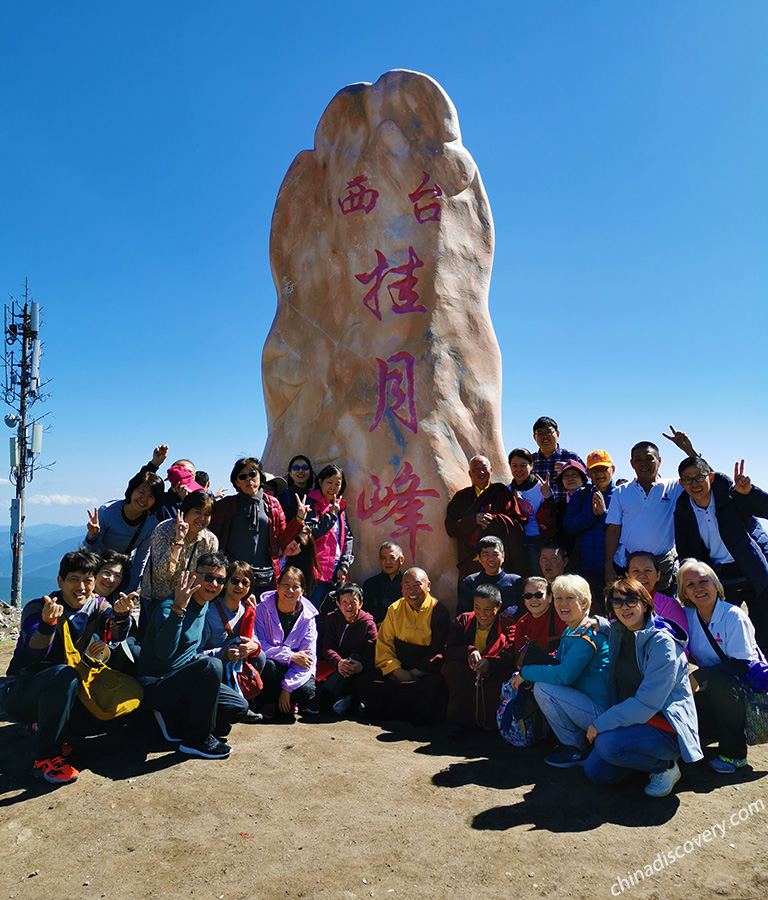
Our Guests at Guayue Peak

Our Guests at Foguang Temple
4. Mount Jiuhua in Anhui - Buddhist Misterioso of Lotus
Recommended Rating: 
TripAdvisor Impression: Heaven on the Earth, Loving Nature, Sacred Mountain, Amazing and Relaxing Place, Totally Enthralled
Type: Religious Site, Nature & Parks, Mountain
Elevation: 1344.4m(44113ft)
Best Travel Time: March to October (March to October). The weather and scenery in Spring and Autumn are the best for travelling.
Recommended Visiting: one ~ two days
Ticket: CNY160 in Peak Season (January 15 - November 14) and CNY140 in Off Season (November 15 - January 14); cableways and sightseeing bus expenses are excluded.
Location: Qingyang County, Chizhou City, Southern Anhui Province, China; about 130km of northwest Mount Huangshan
Mount Jiuhua, a National Cultural and Natural Heritage and Geopark, is known as the shrine Ksitigarbha Buddha (地藏菩萨)once practiced Buddhism and one of the four most sacred Buddhist mountains in China. Initially named Mount Jiuzi, later it was renamed into Mount Jiuhua according to a poem by great poet Libai during Tang Dynasty - nimbus is divided to two kinds, sacred mountain generates nine glories to praise the beauty of Mount Jiuhua.
The first religion developed in Mount Jiuhua was Chinese Taoism. Buddhism didn’t get initial sowing after introduced from India in Han Dynasty for the geographical isolation and politic factors. Until middle & late Tang Dynasty, Buddhism was gradually accepted and spread in Mount Jiuhua along with construction of more Buddhist temples.
Exploration of precious Buddhist statues, scriptures and antiques in the following temples among all the extant 78 sites gives you fully understanding of Buddhist culture in Mount Jiuhua, including the Huacheng Temple (化城寺 - ashram of Ksitigarbha Bodhisattva & ancestral temple of longest history), Tiantai Temple (天台寺 - the highest temple of Mount Jiuhua on summit of Tiantai Peak), Longevity Palace (百岁宫 – the only temple worships five hundred sitting statues of Rohan in China), Incarnation Grand Hall (肉身宝殿 - site reserves body of Ksitigarbha Bodhisattva),Zhiyuan Temple (祗园寺 - the only palatial temple) . Moreover, outstanding natural scenery viewed from main peaks such as Shiwang Peak (十王峰- the highest peak lying 1342 above sea level) offer additional leisure for your trip on Mount Jiuhua.
Highlights: The Incarnation Grand Hall, Longevity Palace, Huacheng Temple, Zhiyuan Temple, Heavenly Terrace Peak
Activity: Buddhism Activity
Nearby Attractions: Yellow Mountain (Mt. Huangshan), Hongcun Ancient Village and Huizhou Ancient City
Tips:
1. The ticket is only valid within one day.
2. There are many temples on your way up, but photos are not permitted in some temples.
Most Recommended Trips:
☛ 2 Days Mount Jiuhua Buddhism Tour
☛ 4 Days Mount Jiuhua & Shanghai Essence Tour
>> Check more about Anhui Tours & Best Anhui China Tour Packages
Tips and Etiquettes for Buddhist Mountain Tour
1. Select a Best Travel Time. Usually Spring and Autumn are the best season to visit Buddhist mountains when weather is quite pleasant and natural scenery is most beautiful. It probably be rainy in Summer and kind of cold in Winter, especially for mountains at high elevation.
2. Admission Fee of Buddhist Temple. Almost all Buddhist temples visiting needs to buy tickets separately, for the admission fees are excluded in the entrance tickets of Buddhist mountains.
3. Preparations before Buddhist Mountain Tour. Remember to take some warm clothes for huge temperature variation between day and night, foothill and top, rain gear in case of raining, comfortable shoes and necessary food supply.
4. Buddhism Etiquettes Should Follow:
―enter temples from side door
―no touch and photo takingf of Buddha
―don’t point Buddharupa with fingers
―don’t light the incense from censer
―put your palms together when meeting monks and no handshake, embrace and touch of head with monks
―palms should be facing up when making worships in temples
Believer of Buddhism can pay close attention to the Buddhism activity news if you are interested in. And please respect the temple customs once you choose to live in temple.
Travel with China Discovery
If you want to get rid of hustle of public transportation and troublesome navigation, you can take a private tour package which covers sightseeing, dining and transfer from us. Our local tour guide and driver will escort you to any destinations with speed and convenience, and take care of all the details. You just need to focus on sightseeing. If you have more questions about Buddhist Mountains in China, please feel free to contact us and our professional travel consultants are here ready to help!
Top Buddhist Mountain in China
Recommended Travel Articles
Recommended Tours
Top 3 tours chosen by most customers to explore in the best way. Check the detailed itinerary, or tailor your own trip now with us.

3 Days Mount Emei Buddhist Pilgrimage Tour
Chengdu / Mount Emei / Leshan Giant Buddha / Chengdu

6 Days China Mountains Tour with Classic Shanghai
Shanghai / Jiuhuashan / Huangshan

8 Days Ancient Beijing & Shanxi Culture Tour
Beijing / Datong / Wutaishan / Pingyao
Start planning your tailor-made holiday to China by contacting one of our specialists. Once inquired, you’ll get a response within 0.5~23.5 hours.
Customize a TripHave a question? Get answers from our travel experts or guests
- Your Question:
- Your Name:
- Your Email:
- Submit



























